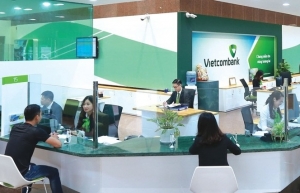The short-term implications of SBV credit room lift
The State Bank of Vietnam (SBV) continues to adjust the credit room. With only weeks left until the end of the year, what do you make of it?
 |
| Tran Thi Khanh Hien, director of VNDirect’s Analysis Division |
At present, global inflation has tended to peak. Most of the market is predicting that the US Federal Reserve will raise the operating interest rate to 5 per cent in the first half of 2023 and a rate cut of about 25 basis points by the end of 2023 or the first quarter of 2024. Similarly, other central banks such as the European Central Bank can also reduce the rate of interest rate hikes in 2023, and inflation will drop to an acceptable level.
Domestically, inflation has been somewhat controlled, the USD/VND exchange rate has dropped below 24,000, and the liquidity of the interbank system has stabilised. Therefore, we believe that the SBV’s decision to increase the credit limit is reasonable to ease market liquidity stress at the end of the year, when enterprises’ capital needs are very urgent.
According to the SBV, as of early December, credit growth reached 12.2 per cent. Compared to the original plan of 14 per cent, there is still room for 1.8 per cent more. Although the expansion is a temporary solution, when the pressures in the corporate bond market have not been resolved satisfactorily, this is still positive news for the financial market and businesses in particular.
The SBV said that the system liquidity tension has eased. Would banks have money to lend?
Currently, there is no official announcement on the growth rate allocation ratio, but the SBV has allocation principles, in which priority is given to banks with better liquidity, as well as banks that make efforts to cut reduce interest rates to support businesses.
At present, commercial banks are still under pressure to balance capital when the credit-mobilisation gap is widening. As of September 20, credit institutions’ deposits increased by 4.04 per cent, while the credit growth of the economy reached 10.54 per cent. This growth difference is the cause of the spike in input interest rates since the beginning of the year, as well as commercial banks’ high loan-to-deposit ratio (LDR).
According to our estimates, at the end of the third quarter, all commercial banks recorded an increase in LDR compared to the end of 2021, and some banks were close to the threshold. Therefore, if the regulations on lending remained the same, only a few commercial banks would solve the liquidity problem and be able to give out new loans.
Will adjusting the credit room cause the system to strain again, and what should be the solution if tension occurs?
The SBV has developed a plan to prepare for this situation. Along with the decision to adjust credit growth, it has restarted lending with valuable papers pledged and expanding the number of valuable papers allowed to be pledged, according to Circular No.16/2022/TT-NHNN, showing readiness to support liquidity in the near future.
Loosening the credit room is a temporary solution, and there are only a few commercial banks that meet the criteria to be allocated more limits. Therefore, this move is mainly to relieve stress for businesses that are managing sources and extending old loans; the rest will not see too great an impact. We are waiting for more information from the regulatory agency on whether to adjust the criteria and regulations on lending.
In the medium and long term, the implementation of policies to remove bottlenecks for corporate bonds is a factor worth waiting for, as this is an important long-term capital channel besides bank credit.
How do you think credit for 2023 should be calculated?
Entering the first months of 2023, the pressure on interest rates and exchange rates will still be considerable, when the Fed still maintains the momentum of raising interest rates by at least 125 basis points, and the corporate bond issues are still there. Pressure on interest rates and exchange rates will be partly relieved from mid-2023 via the combination of two factors – the Fed’s decisions and the improvement of Vietnam’s foreign exchange reserves – which will prevent the devaluation of the VND, and interest rates will tend to decrease gradually.
Credit growth will be slow in the first half of the year and more prosperous in the second half of 2023, with the whole year sitting at 11-12 per cent. Firstly, this is because the real estate market is still less positive when investors face difficulties in accessing capital as well as the increased risk of payment for mature corporate bonds.
Secondly, some of Vietnam’s economic engines are slowing down when the risk of a global economic recession is growing and consumer demand declines. Exports, one of Vietnam’s main growth pillars, will slow down to around 9-10 per cent in 2023 from 14 per cent in 2022.
Domestic consumer services, which have been one of the drivers of GDP growth after the pandemic, will also slow down as the scale of production shrinks and the labour market is quiet. Businesses will temporarily stop expanding production and business activities in the context of high interest rates and weak consumer demand. Thirdly, in addition to the LDR currently at a relatively high threshold which reduces the room for new loans as mentioned, the capital adequacy ratio (CAR) is also a limiting factor in the credit capacity of some commercial banks.
In recent years, Vietnamese commercial banks have been trying to improve CAR. Currently, there are more than 20 banks that have applied Basel II standards, of which six banks have completed all three pillars. A few banks have already started the preparation phase for Basel III.
However, the capital buffer of Vietnamese banks is still relatively thin compared to other countries, in which the group of state-owned joint-stock commercial banks, accounting for nearly half of the lending market share, has an average CAR of only 9 per cent, slightly higher than the minimum prescribed level of 8 per cent.
 | Squeeze in allotted credit room for commercial banks The rapid expansion of credit and lending activities in the first few months of this year have prompted commercial banks to run out of credit lines, which had been temporarily allotted by the State Bank of Vietnam at the start of the year. |
 | Charter capital boost offers new credit room A handful of credit institutions are raising their charter capital in a bid to strengthen their financial buffer and competitiveness, while maintaining their capital adequacy ratio as required by regulators. |
 | Investors and buyers play waiting game in credit switch The State Bank of Vietnam finally created extra credit room for some banks on September 7. However, the extension is deemed low and may not help real estate businesses and homebuyers access feasible capital sources for their projects. |
 | Four banks have adjusted credit room The State Bank of Vietnam (SBV) has officially adjusted the credit room for four banks in a bid to support weak credit institutions according to the government's policy. |
What the stars mean:
★ Poor ★ ★ Promising ★★★ Good ★★★★ Very good ★★★★★ Exceptional
Related Contents
Latest News
More News
- Tax sector wraps up 2025 and sets priorities for next year (December 25, 2025 | 14:00)
- A tipping point for digital and hybrid wealth management in Vietnam (December 23, 2025 | 13:33)
- $250 million deal targets women-owned SMEs, sustainable agriculture (December 22, 2025 | 17:40)
- Stock market posts resilient 2025 performance (December 19, 2025 | 18:17)
- Citi Vietnam receives 2025 AmCham CSR recognition (December 19, 2025 | 16:35)
- As global green supply chain reshapes, will Vietnam be left behind? (December 19, 2025 | 08:00)
- Banks gear up for massive capital increases (December 18, 2025 | 17:04)
- Securing capital and efficiency for Vietnam’s 2026-2030 growth ambitions (December 17, 2025 | 10:00)
- Energy sector in need of blended finance mechanisms (December 17, 2025 | 09:00)
- Vietnam still has room to mobilise capital for sustainable growth (December 17, 2025 | 08:57)

 Tag:
Tag:





















 Mobile Version
Mobile Version